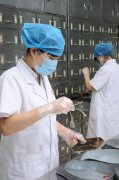Nephrotic syndrome
Pathogeny
There
are three kinds of primary , secondary and hereditary diseases . Primary NS
belongs to primary glomerular disease and has many pathological types .
Symptoms
The
most basic features of NS are massive proteinuria , hypoproteinemia , high
swelling and hyperlipidemia , a group of clinical syndromes characterized by
the so-called “ three highs and one low ” and other metabolic disorders .
1. Massive
proteinuria
Proteinuria
is the most important clinical manifestation in patients with NS , and it is
also the most basic pathophysiological mechanism of nephrotic syndrome . A
large amount of proteinuria refers to >3.5g/d of adult urine protein
excretion . Under normal physiological conditions , the glomerular filtration
membrane has a molecular barrier and a charge barrier , the protein content in
urine increased , a large amount of proteinuria occurs when the absorption
capacity of the proximal convoluted tubule is much higher than that of the
proximal convoluted tubule .
2. Hypoproteinemia
Plasma
albumin decreased to <30g/L , a large amount of albumin is lost from urine
during NS , which promotes the compensatory synthesis of albumin and the
increase of tubular decomposition in liver . Hypoalbuminemia occurs when
albumin synthesis in the liver is not increased enough to overcome loss and
decomposition . In addition , NS patients with gastrointestinal mucosal
swelling leading to poor appetite , insufficient protein intake , malabsorption
or loss , also aggravate hypoproteinemia .
3. Swelling
Hypoproteinemia
and plasma colloid osmotic pressure decreased at NS , the main reason for NS
swelling is that the water enters the interstitial space from the lumen of
vessel .
4. Hyperlipidemia
Hypercholesterolemia is mainly due to
increased lipoprotein synthesis in the liver , but decomposition also plays a
part in the surrounding circulation . Hypercholesterolemia is mainly due to
metabolic disorders , and liver synthesis is a secondary factor .
三、Treatment
1. Generally
treatment
All
patients with severe swelling and hypoproteinemia should be kept in bed rest .
After the swelling disappeared and the generally condition improved , the
activity of getting up can be raised . A high protein diet with normal quantity
of 0.8~1.0g/(kg/D) was given . Heat should be fully guaranteed . Daily weight
should not be less than 30 to 35 kcal per kilogram . Swelling should be low
salt ( less than 3g/d ) diet . In order to reduce hyperlipidemia , we should
reduce the diet rich in saturated fatty acids ( animal fats ) .
2. Symptomatic
treatment
(1)
Diuresis
detumescence
(2)
Reduce
protein in urine
3. Primary
treatment
(1)
Glucocorticoid
therapy
(2)
Cytotoxic
agents
(3)
Immunosuppressive
agents



评论
发表评论